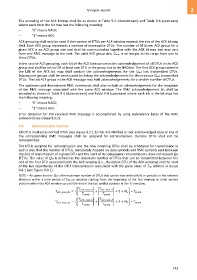Page 753 - 5G Basics - Core Network Aspects
P. 753
Transport aspects 2
The encoding of the ACK bitmap shall be as shown in Table 9-5 (downstream) and Table 9-8 (upstream)
where each bit in the bit map has the following meaning:
– "0" means NACK;
– "1" means ACK.
ACK grouping shall only be used if the number of DTUs per ACK window exceeds the size of the ACK bitmap
field. Each ACK group represents a number of consecutive DTUs. The number of DTUs per ACK group for a
given ACK is an ACK group size and shall be communicated together with the ACK bitmap and may vary
from one RMC message to the next. The valid ACK group size, Gack, is an integer in the range from one to
three DTUs.
In the case of ACK grouping, each bit of the ACK bitmap carries the acknowledgement of all DTUs in the ACK
group and shall be set to 0 if at least one DTU in the group has to be NACKed. The first ACK group coded in
the LSB of the ACK bit map shall contain the acknowledgements for the Gack last transmitted DTUs.
Subsequent groups shall be constructed by taking the acknowledgements for the previous Gack transmitted
DTUs. The last ACK group in the ACK message may hold acknowledgements for a smaller number of DTUs.
The upstream and downstream RMC commands shall also include an acknowledgement for the reception
of the RMC message associated with the same ACK window. The RMC acknowledgement bit shall be
encoded as shown in Table 9-5 (downstream) and Table 9-8 (upstream) where each bit in the bit map has
the following meaning:
– "0" means NACK;
– "1" means ACK.
Error detection for the received RMC message is accomplished by using redundancy bytes of the RMC
codeword (see clause 9.6.3).
9.8 Retransmission function
All DTUs marked as normal DTUs (see clause 8.2.1.3) that are NACKed or not acknowledged (due to loss of
the corresponding RMC message) shall be assigned for retransmission. Dummy DTUs shall not be
retransmitted.
The DTUs assigned for retransmission and the new incoming DTUs shall be scheduled for transmission in
such a way that the number of DTUs, completely mapped on data symbols and RMC symbols sent between
the end of transmission of a given DTU and the start of its subsequent retransmission, does not exceed Qtx
DTUs. The value of Qtx is defined as the maximum number of DTUs that can be transmitted between the
end of the first DTU associated with the ACK window (i.e., the oldest DTU of the ACK window) and the start
of the last opportunity of this DTU retransmission associated with the given value of Tret defined in clause
9.8.1 (see Figure 9-9.1).
NOTE – An upper limit on Qtx is the maximum number of DTUs that can be transmitted fully or partially in the relevant
direction within a time period of Tqtx_max seconds starting from the beginning of the first (earliest in time) symbol
position within the ACK window up until the end of the last symbol position in the Tret window.
_ _ = (⌈ _max _ ⌉ + ⌈ _max _ ⌉ + 2 + ) ∗
_ _ = (⌈ _max _ ⌉ + ⌈ _max _ ⌉ + 2 + ) ∗
743

